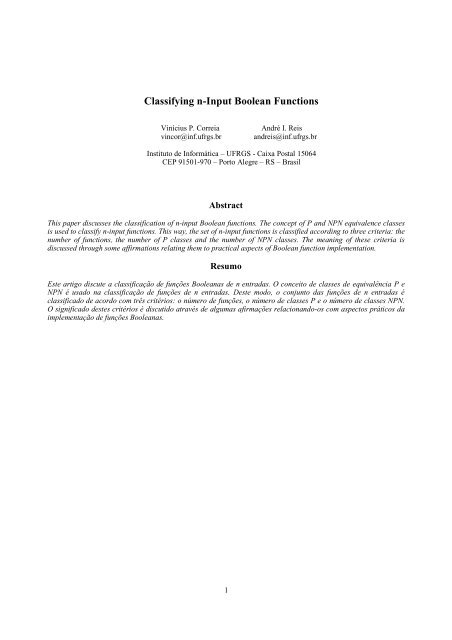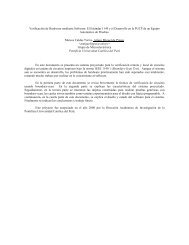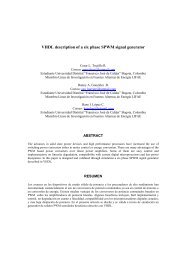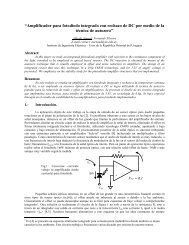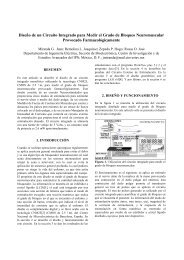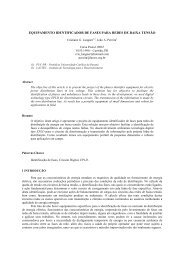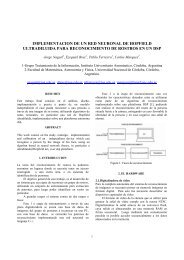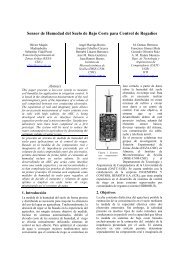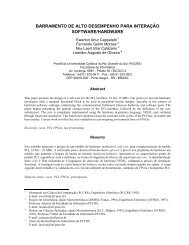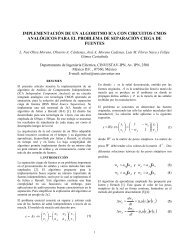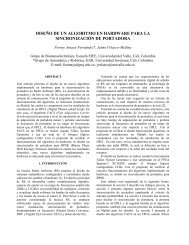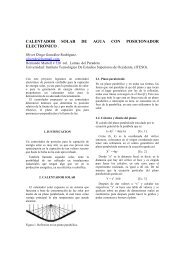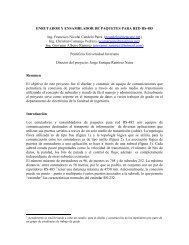Classifying n-Input Boolean Functions
Classifying n-Input Boolean Functions
Classifying n-Input Boolean Functions
Create successful ePaper yourself
Turn your PDF publications into a flip-book with our unique Google optimized e-Paper software.
<strong>Classifying</strong> n-<strong>Input</strong> <strong>Boolean</strong> <strong>Functions</strong><br />
Vinícius P. Correia<br />
vincor@inf.ufrgs.br<br />
André I. Reis<br />
andreis@inf.ufrgs.br<br />
Instituto de Informática – UFRGS - Caixa Postal 15064<br />
CEP 91501-970 – Porto Alegre – RS – Brasil<br />
Abstract<br />
This paper discusses the classification of n-input <strong>Boolean</strong> functions. The concept of P and NPN equivalence classes<br />
is used to classify n-input functions. This way, the set of n-input functions is classified according to three criteria: the<br />
number of functions, the number of P classes and the number of NPN classes. The meaning of these criteria is<br />
discussed through some affirmations relating them to practical aspects of <strong>Boolean</strong> function implementation.<br />
Resumo<br />
Este artigo discute a classificação de funções <strong>Boolean</strong>as de n entradas. O conceito de classes de equivalência P e<br />
NPN é usado na classificação de funções de n entradas. Deste modo, o conjunto das funções de n entradas é<br />
classificado de acordo com três critérios: o número de funções, o número de classes P e o número de classes NPN.<br />
O significado destes critérios é discutido através de algumas afirmações relacionando-os com aspectos práticos da<br />
implementação de funções <strong>Boolean</strong>as.<br />
1
1 Introduction<br />
The design of digital circuits involves a deep understanding of the concept of <strong>Boolean</strong> <strong>Functions</strong>. There are many<br />
operations usually applied in the digital circuit synthesis process. Many of these operations depend on the search<br />
space under consideration. This is the case of the matching phase performed during technology mapping [10], where<br />
a function (or only part of it) to be implemented is matched against cells from a library. Sometimes this matching is<br />
limited to cells with a maximum number of inputs. The goal of this paper is to classify n-input functions in order to<br />
have a precise idea about the search space of the whole set of n-input functions. The emphasis of the paper is on how<br />
to use some equivalence classes to reduce the search space, and on the meaning of these equivalence classes.<br />
For a given number of input variables, there is a well-defined number of functions. This number is given by 2^(2^n),<br />
where n is the number of input variables. Each n variable function has 2^n possible minterms, resulting in a truth<br />
table with 2^n lines. This is shown in figure 1 for the case of 2-input <strong>Boolean</strong> functions. The 2^n possible minterms,<br />
or lines of the truth table, give the number of bits in each column of the truth table. This way, the output columns of<br />
the truth tables characterize a given <strong>Boolean</strong> function as a binary number of 2^n bits. As there are 2^(2^n) numbers<br />
of 2^n bits, there are 2^(2^n) possible different functions of n inputs. This is also shown in figure 1 for the case of 2-<br />
input functions.<br />
Figure 1: All the 16 different 2-input functions.<br />
Table 1 contains the information on the number of n-input functions for n varying from 2 to 4. It is possible to see<br />
that for the case of 4-input functions the search space is almost intractable if many operations need to be repeated.<br />
Table 1: Number of functions with 2, 3, 4 and n variables<br />
Number of inputs Number of functions<br />
2 16<br />
3 256<br />
4 65536<br />
n<br />
2^(2^n)<br />
The n-input functions can be classified into different classes (set of functions) in order to reduce the search space.<br />
The number of functions is the first number to be considered in the classification of the set of n-input functions.<br />
Other two numbers that could be used in the classification of n-input functions are the numbers of P and NPN<br />
equivalence classes. As it will be discussed later, P classes group functions that are equivalent under input<br />
permutation while NPN classes group functions that are equivalent under input negation/permutation as well as<br />
output negation.<br />
The data structures used to verify function equivalence in this paper are the Binary Decision Diagrams (BDDs) [1].<br />
BDDs are the most used form to represent <strong>Boolean</strong> functions in Electronic Design Automation. There are many<br />
specific kinds of BDDs, depending on its use. Reduced Ordered Binary Decision Diagrams (ROBDDs) are<br />
commonly used to compare <strong>Boolean</strong> functions using the ROBDD strong canonical form (unique representation)<br />
presented in [2]. This canonical form is necessary to verify the equivalence of the functions and group them into a<br />
common equivalence class. More details about BDDs can be found in [1][2][3][4].<br />
This paper is organized as follows. The implementation of n-input functions is discussed in section 2. Sections 3 and<br />
4 introduce the concepts of P classes, and NPN classes, respectively. Section 5 presents some results for the<br />
2
classification of 2, 3 and 4-input functions. The concepts introduced in this paper are worked out in section 6, while<br />
conclusions are discussed in section 7.<br />
2 Implementation of n-input functions<br />
Figure 2: Implementations for all the 16 different 2-input functions.<br />
The number of different n-input functions is 2^(2^n), as already demonstrated in section 1. Figure 2 shows the gates<br />
needed to implement each of the 2-input functions from figure 1. Note that many different functions are implemented<br />
using the same gates.<br />
3 The concept of P class<br />
The fact that many different 2-input functions may have the same gate-level implementations naturally introduces the<br />
concept of P equivalence. P equivalence between 2 functions is obtained when it is possible to achieve identical<br />
values for both truth table outputs by permuting the function inputs. <strong>Functions</strong> that are P equivalent can be grouped<br />
into P classes. For instance, the functions and are P equivalent. Figure 3 shows all the 12<br />
different P classes of 2-input functions. It is important to note that despite the existence of 16 different 2-input<br />
functions, there are only 12 different 2-input P classes. The circuits used to implement each P class are also shown in<br />
figure 3. Four P classes are composed by 2 functions, while eight P classes are composed by only one function. The<br />
most important property of P equivalent functions is that they can always be implemented with the same circuit (or<br />
cell from a library). Therefore, it is possible to implement any of the 2-input functions with a single cell from a<br />
library composed of one gate implementation for each P class.<br />
3
4 The concept of NPN class<br />
Figure 3: The 12 different 2-input P classes.<br />
From figure 3, it is possible to see that even P classes may have similar implementations. For instance, functions f 1<br />
,<br />
f 2<br />
, f 4<br />
, f 7<br />
, f 8<br />
, f 11<br />
, f 13<br />
and f 14<br />
have gate implementations based on a single nand gate plus some inverters. These functions<br />
may be grouped into a NPN equivalence class. NPN equivalence between 2 functions is obtained when it is possible<br />
to achieve identical values for both truth table outputs by permutation and/or negation of the function inputs and/or<br />
negation of the function output. Figure 4 shows all the 4 different NPN classes of 2-input functions, one NPN class<br />
per line. It is important to note that despite the existence of 16 different 2-input functions, there are only 4 different<br />
2-input NPN classes. There are 2 NPN classes composed of 2 functions, one NPN class composed of 4 functions,<br />
and one NPN class composed of 8 functions. NPN equivalent functions can be implemented with the same circuit<br />
plus some inverters (used in the negation operations for the inputs and the output, if necessary). This way, it is<br />
possible to use a smaller library composed of one representative gate for each NPN class plus one inverter cell. This<br />
approach is specially useful when the cost of the inverter is very low.<br />
5 Results<br />
Figure 4: The 4 different 2-input NPN classes.<br />
4
In order to classify n-input functions into P and NPN classes, a tool that constructs minimal implementations of<br />
<strong>Boolean</strong> functions in the ROBDD strong canonical form was implemented. By performing input permutations, the<br />
set of P classes is derived. By performing permutation/negation at the inputs and negation at outputs the set of NPN<br />
classes is derived. As the equivalence-checking tool is based on ROBDDs, we used the number of nodes in the final<br />
ROBDD implementation as a parameter of the relative complexity of functions and classes. Results are shown in<br />
tables 2, 3 and 4, respectively, for 2-input, 3-input and 4-input functions.<br />
Table 2: Number of 2-input functions, P classes and NPN classes according to their ROBDD size.<br />
Nodes BDDs P NPN<br />
0 2 2 1<br />
1 4 2 1<br />
2 8 6 1<br />
3 2 2 1<br />
Total 16 12 4<br />
Table 3: Number of 3-input functions, P classes and NPN classes according to their ROBDD size.<br />
Nodes BDDs P NPN<br />
0 2 2 1<br />
1 6 2 1<br />
2 24 6 1<br />
3 62 26 4<br />
4 88 30 4<br />
5 74 14 3<br />
Total 256 80 14<br />
Table 4: Number of 4-input functions, P classes and NPN classes according to their ROBDD size.<br />
Nodes BDDs P NPN<br />
0 2 2 1<br />
1 8 2 1<br />
2 48 6 1<br />
3 236 26 4<br />
4 960 204 14<br />
5 3248 710 38<br />
6 8928 1342 70<br />
7 17666 1272 68<br />
8 23280 420 25<br />
9 11160 0 0<br />
Total 65536 3984 222<br />
The results presented in table 2 confirm the number of 2-input functions, P classes and NPN classes discussed earlier<br />
in figures 1 to 4. Table 4 shows the number of different 4-input functions, P and NPN classes, according to the size<br />
of its ROBDD representation. First column shows the BDD sizes considering the number of non-terminal nodes.<br />
BDD sizes vary from 0 to 9, and this is compatible with the upper bound for BDD size derived in [4]. All the BDD<br />
sizes in table 1 were obtained with the same variable ordering [3]. In the case of P and NPN classes, the smaller<br />
BDD size for the functions belonging to the class is considered.<br />
Table 5: Number of functions, P classes, and NPN classes according to the number of inputs.<br />
5
# of inputs <strong>Functions</strong> P classes NPN classes<br />
1 4 4 2<br />
2 16 12 4<br />
3 256 80 14<br />
4 65536 3984 222<br />
6 Working out the concepts<br />
In order to understand the criteria that were used for the classification of n-input functions, some related affirmations<br />
will be discussed. As the examples involves the concept of Universal Logic Gates (ULGs), we will begin by<br />
explaining this concept.<br />
6
6.1 The concept of ULG<br />
An Universal Logic Gate (ULG) is a programmable logic gate that can implement several different logic functions,<br />
according to its configuration. The term Universal was introduced because this kind of gate normally can implement<br />
all the n-input functions for a given n. This way an Universal logic gate could implement all the universe of n-input<br />
functions. However, this is not always true. For instance, if an ULG is able to implement all the n-input functions, it<br />
is not necessarily able to implement all the (n+1)-input functions. This way an ULG can only implement a limited<br />
number of functions, P classes or NPN classes. A classic example of implementation of an ULG as a binary decision<br />
tree is shown in figure 5. In this binary decision tree, a variable is evaluated at each level. If the variable value is 0,<br />
the left arc is activated. Otherwise, the value is 1 and the right arc is activated. This way, if abc=101 then the output<br />
value is the minterm m 5<br />
. The ULG works similarly for all the other minterm values, represented as squares in figure<br />
5. These minterms are stored in flip-flops, therefore they are programmable to be equal to 0 or 1. Decision nodes,<br />
represented in figure 5 as circles, are implemented with multiplexors.<br />
6.2 How many cells in the library?<br />
Figure 5: ULG viewed as a binary decision tree.<br />
Based on the ULG implementation presented in figure 5, it is possible to state some misleading conclusions which<br />
unadvertised people could accept as true.<br />
Fallacy: This ULG is able to implement all the 256 3-input functions, so it is as powerful as a cell library<br />
composed of 256 cells.<br />
This is not true, because several different 3-input functions may be implemented with the same circuits. These<br />
functions are grouped in P classes. Therefore, it is necessary only 80 (the number of 3-input P classes) cells in a<br />
library able to implement any of the 3-input functions with only one cell.<br />
6.3 How to measure ULGs?<br />
The question raised in the previous subsection leads to another question: Which number should be used to measure<br />
the efficacy of an ULG? There are 3 criteria: the number of functions, P classes or NPN classes it is able to<br />
implement. The number of functions is not a good criterion because many functions have the same implementation.<br />
Therefore, the number of P classes was used. What about to use the number of NPN classes?<br />
Pitfall: My ULG is able to implement 180 out of the 222 NPN classes of 4-input variables.<br />
This affirmation is correct only if the ULG provides a mean to implement input and output negation. This way, the<br />
ULG can implement complete NPN classes. If the input/output negation is not allowed, the ULG will be able to<br />
implement some NPN classes only partially. Some functions of the NPN class can be implemented while others<br />
7
cannot. This way, it makes no sense to say that this NPN class can be implemented neither to say that it cannot. The<br />
best number to be used to classify ULGs is the number of P classes that it can implement, because input permutation<br />
of a cell is always allowed. If input/output negation is available at no cost, it makes sense to use NPN classes for<br />
classification. The origin of this pitfall is that the first ULGs allowed input/output negation, thus it was possible to<br />
classify them by using NPN classes. Afterwards, new ULGs that did not allow input/output negation were proposed,<br />
leading to this pitfall.<br />
6.4 The cost of an ULG<br />
At this point an attentive reader could ask the following question:<br />
Disturbing question: Why use ULGs if every <strong>Boolean</strong> function can be implemented by using only 2-input<br />
nand cells?<br />
The use of ULGs offers programmability at later levels of implementation. For instance, there are circuits based on<br />
ULGs that can be quickly customized by using the higher metal levels. FPGAs based on RAM can be programmed<br />
more than once. The cost of an ULG is usually higher than an implementation using several cells from a library, but<br />
this cost is compensated by the programmability. When using cells from a library, it doesn’t matter how many cells<br />
are used to implement each logic function, only the final cost matters. For ULG based logic, it is interesting to have<br />
more powerful ULGs that are able to implement a larger number of functions, while maintaining the cost of the<br />
ULGs as low as possible.<br />
6.5 When inverters have no cost?<br />
As the criterion used (P or NPN classes) in the classification depends on the cost of input/output inversion, it is<br />
interesting to discuss when inverters have no cost. In the case of ULGs, it is possible to invert input variables that are<br />
selection variables of multiplexors: it is possible to invert these variables by exchanging the multiplexed functions.<br />
The negation of the outputs can be easily done when the minterms are stored in flip-flops. However, even for<br />
multiplexor and flip-flop based ULGs, the inversion operation may not be available for all the inputs/outputs due to<br />
hardwired connections. This way, it is necessary to be very careful when using NPN classes to measure the efficacy<br />
of ULGs.<br />
8
7 Conclusion<br />
This paper discussed the classification of n-input functions considering the number of functions, P classes and NPN<br />
classes. The number of P classes is the best criteria, because each P class corresponds to a single implementation,<br />
and input permutation is always allowed. A BDD based tool that groups functions into P and NPN classes was<br />
developed in order to enumerate the number of P and NPN classes of n-input functions. Future work will include an<br />
investigation of minimal implementations for each P class considering several kinds of logic, like static CMOS logic<br />
[5], pass transistor logic[6] [7], and the ones used in [8] [9].<br />
8 References<br />
[1] R.E.Bryant. "Graph-based algorithms for <strong>Boolean</strong> function manipulation", IEEE Transactions on Computers, vol. C-35, n° 8, pp. 677-691,<br />
August 1986.<br />
[2] K.S.Brace, R.L.Ruddel, R.E.Bryant. "Efficient implementation of a BDD package". Proc. of 27th DAC, pp. 272-277, 1990.<br />
[3] Steven J. Friedman and Kenneth J. Supowit, "Finding the Optimal Variable Ordering for Binary Decision Diagrams", IEEE Transactions on<br />
Computers, Vol. 39, No. 5,pp. 710-713, May 1990.<br />
[4] Heh-Tyan Liaw and Chen-Shang Lin, "On the OBDD-Representation of General <strong>Boolean</strong> <strong>Functions</strong>", IEEE Transactions on Computers, Vol.<br />
41,No. 6, pp. 661-664, June 1992.<br />
[5] T. Ibaraki, S. Muroga, "Synthesis of Networks with a Minimun Number of Negative Gates", IEEE Transactions on Computers, Vol. C-20, No.<br />
1,pp. 49-58, January 1971.<br />
[6] P. Buch, A. Narayan, A. R. Newton, A. Sangiovanni-Vincentelli, "On Synthesizing Pass Transistor Networks", IWLS '97, pp. 101-108.<br />
[7] V. Bertacco, S. Minato, P. Verplaetse, L. Benini, G. de Micheli, "Decision Diagrams and Pass Transistor Logic Synthesis", IWLS '97, pp. 109-<br />
113, May 1997.<br />
[8] Charles R. Baugh, C. S. Chandersekaran, Richard S. Swee and Saburo Muroga, "Optimal Networks of NOR-OR Gates for <strong>Functions</strong> of Three<br />
Variables", IEEE Transactions on Computers, Vol. C-21, No. 2,pp. 153-160, February 1972.<br />
[9] J. N. Culliney, M. H. Young, T. Nakagawa and S. Muroga, "Results of the Synthesis of Optimal Networks of AND and OR Gates for Four-<br />
Variable Switching <strong>Functions</strong>", IEEE Transactions on Computers, Vol. C-27, No. 1,pp. 76-85, January 1979.<br />
[10] E. Detjens, G.Gannot, R.Rudell, A.L.Sangiovanni-Vinccentelli, A.Wang. "Technology mapping in MIS" ICCAD, 1987, pp. 116-119.<br />
9


